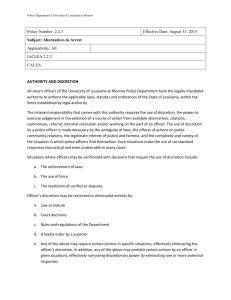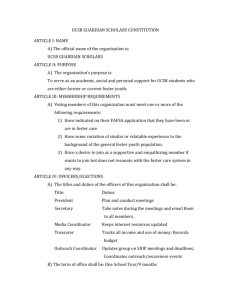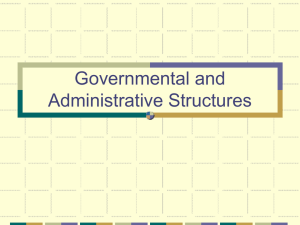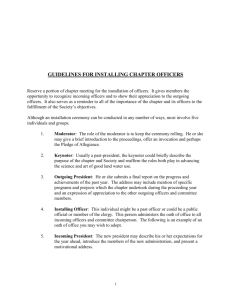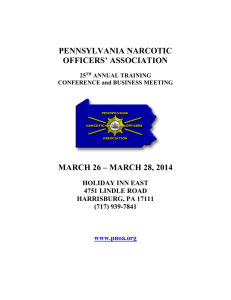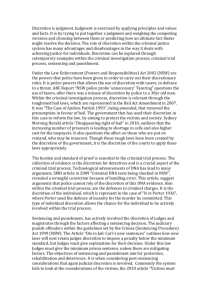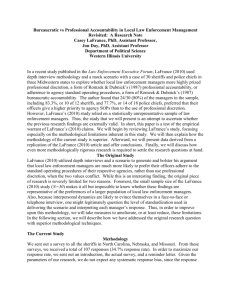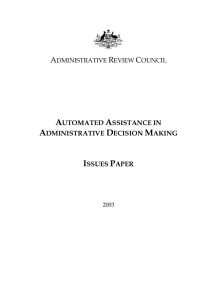Using the Target Model - Politics and Government| Illinois State
advertisement
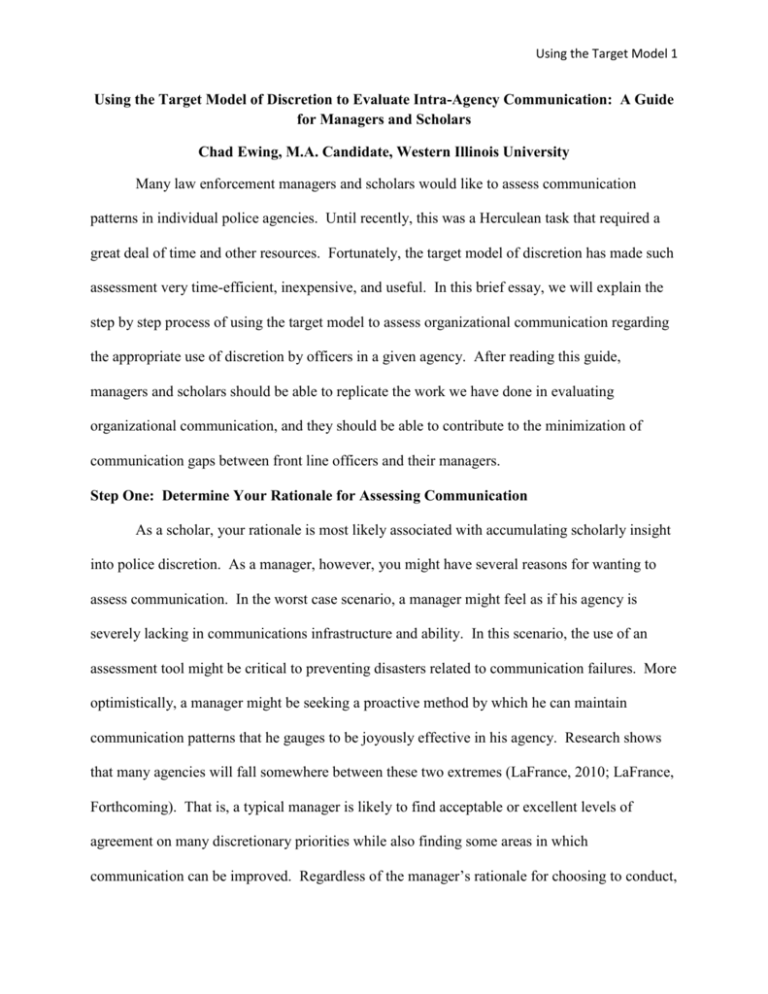
Using the Target Model 1 Using the Target Model of Discretion to Evaluate Intra-Agency Communication: A Guide for Managers and Scholars Chad Ewing, M.A. Candidate, Western Illinois University Many law enforcement managers and scholars would like to assess communication patterns in individual police agencies. Until recently, this was a Herculean task that required a great deal of time and other resources. Fortunately, the target model of discretion has made such assessment very time-efficient, inexpensive, and useful. In this brief essay, we will explain the step by step process of using the target model to assess organizational communication regarding the appropriate use of discretion by officers in a given agency. After reading this guide, managers and scholars should be able to replicate the work we have done in evaluating organizational communication, and they should be able to contribute to the minimization of communication gaps between front line officers and their managers. Step One: Determine Your Rationale for Assessing Communication As a scholar, your rationale is most likely associated with accumulating scholarly insight into police discretion. As a manager, however, you might have several reasons for wanting to assess communication. In the worst case scenario, a manager might feel as if his agency is severely lacking in communications infrastructure and ability. In this scenario, the use of an assessment tool might be critical to preventing disasters related to communication failures. More optimistically, a manager might be seeking a proactive method by which he can maintain communication patterns that he gauges to be joyously effective in his agency. Research shows that many agencies will fall somewhere between these two extremes (LaFrance, 2010; LaFrance, Forthcoming). That is, a typical manager is likely to find acceptable or excellent levels of agreement on many discretionary priorities while also finding some areas in which communication can be improved. Regardless of the manager’s rationale for choosing to conduct, Using the Target Model 2 or participate in, this assessment, the manager must be cognizant that doing so will bring some skeletons out of his agency’s closet. Frankly, this tool forces managers to recognize shortcomings in their organizational communication patterns. If the manager is unwilling to acknowledge that his agency is not perfect, the assessment will be a waste of the time and effort of all subjects involved. If, however, the manager is willing to suffer a temporarily bruised ego, he is likely to be rewarded in the long run with the pride of knowing that he has enhanced organizational communication in his agency, and possibly, avoided negative outcomes associated with flawed communication. Step 2: Share Your Intentions with Members of Your Department, Emphasize Anonymity, and Publicize the Distribution/Collection Date After you have evaluated your intentions for conducting this analysis, share these intentions with all members of the agency. This will be a chance for you to emphasize the importance of the project to the agency as a whole and to encourage participation. Here, too, the manager or scholar might emphasize that he is only looking for aggregate patterns in responses and is not seeking to single out any member of the agency for retribution. The manager will later reinforce the anonymity of the exercise by asking officers to detach consent/participation forms from their completed surveys and turn each in separately. It is wise to publicize the exercise two or more weeks in advance so that each agency member is aware of the date of survey distribution and collection. Step 3: Distribute the Blank Target and Survey Form (See Appendix) Command staff members and front-line officers will be given variants of the same question. To wit, front line officers will be asked “When thinking of how you use discretion as an officer, how would you rank the importance of each of the following as boundaries on discretion?” while command staff members will be asked, “When thinking of how you would Using the Target Model 3 like for your officers to use discretion, how would you rank the importance of each of the following as boundaries on discretion?” Step 4: Collect the Completed Surveys Anonymously Assign a trusted officer with the task of collecting completed surveys. Task this person with ensuring that each respondent indicated whether he/she is a front line officer or command staff member. Other than this distinction, information that could identify a respondent should be omitted. Step 5: Make a Spreadsheet and Enter Responses By Discretionary Category for Each Rank Level; Conduct an Independent Samples T-test Open a blank Excel worksheet. Enter responses by discretionary influence category (e.g., community norms, legal liability, etc.), in two columns: one for front-line officers and one for command staff members’ responses. Using the sum feature in Excel (∑) add up the number of target rings that members of each group ascribed to this category. Next, take the arithmetical average (mean) from each group by dividing the total number by the number of respondents in each group. Once you have done this, you will take the standard deviation (STDev). Once you have the average for each group and the standard deviation, you will conduct an independent samples t-test, a relatively simple statistical procedure. To conduct the t-test, you will select TTest from the “statistical functions” menu in Excel, and select the option for a two tailed test rather than a one tailed test. More detailed instructions for conducting the t-test are available online at sites such as: http://depts.alverno.edu/nsmt/stats.htm. If you prefer, you may contact a social sciences professor for assistance with running this statistical analysis. Once you have found the t value (the between groups difference), you can check the “critical values for t” table on-line at: http://www.statsoft.com/textbook/distribution-tables/#t. You will need to calculate Using the Target Model 4 the degrees of freedom for the test (the number of total respondents minus 2). Once you know how many degrees of freedom you have, simply match this to your t value and you will know if the result you got is statistically significant (i.e., the results were not derived by mere chance). You may set your threshold for significance at .10 (10 chances in 100 that your results are derived by chance alone) or .05 (5 chances in 100 that your results are derived by chance alone). Each category that yields a significant between groups difference (i.e., a significant t score) is a category that you should examine in the subsequent step. Step 6: Think Deeply About the Results and Take Action Accordingly At this point, the manager or scholar will have put a great deal of work into the assessment. He should take a few moments to evaluate the results and their implications for the agency being studied. While we tend to focus on statistically significant differences (areas for improvement), it is wise to consider the categories of discretionary influence in which no significant differences were found. The lack of statistical differences in response categories between groups is a powerful indication that agency managers are investing tremendous effort in communicating discretionary priorities to front line officers, and these efforts have been successful. In fact, if no significant differences are recorded between response groups, the manager ought to consider planning an event to congratulate all members of his agency on the health of their communication patterns. The manager might also hold an open discussion focused on the best methods by which these communication patterns can continue to yield success. However, if analyses demonstrate that there are categories of discretionary influence that need attention, the manager should study these differences and think of underlying causes. The manager might find it helpful to discuss these issues with other members of the agency’s command staff and, eventually, the front line officers. If a scholar is not involved in the project, Using the Target Model 5 this might be an opportunity for the manager to ask for some guidance from an organization theorist or organization development expert. Such scholarly guidance, while not altogether necessary, might be helpful in helping managers to understand root causes in categorical differences between rank levels. Once root causes have been identified, the manager must create an action plan to arrest them. Step 7: Creating and Implementing an Action Plan The scholar or manager involved in the administration of the survey and analysis of results has an obligation to move beyond diagnosis and offer some suggestions for treating the communication maladies that this process uncovers. While this might seem to be an incredibly daunting task, managers and scholars can simplify matters by revisiting the original purpose of the process. Despite whichever category or categories of discretionary constraint prove worrisome, these are all facets of the same concept: communication between rank levels. That is, if a manager wants to know why his officers have different priorities, he needs to visit with each of them and spend some time outside of his office and in their world. Once he has done so, it is likely that he will be in a better position to choose tools and make decisions aimed at reconciling discretionary priorities. These decisions should become part of a larger strategic plan for enhancing organizational communication in which goals and measurable objectives are agreed upon. Step 8: Seeking Feedback, Re-Testing Once the action plan is implemented, the manager should periodically check to determine progress toward fulfilling objectives en route to satisfying the various goals that he has spelled out. The manager should seek feedback from all members of the organization related to this action plan, and make the adjustments he feels are necessary. After a reasonable period (3-4 Using the Target Model 6 months), the manager should re-test all agency members to see if communication flaws have been resolved in his agency. If not, the process of strategic planning should be reconsidered. A Caveat To This Process A caveat is, indeed, in order. No sane person can honestly expect that priorities will be perfectly aligned between rank levels in a police agency. In fact, these organizations are most often structured in such a fashion that managers buffer the technical core of their agencies from exogenous influences and concerns (Thompson, 1967). Still, the inability to foster perfection should not preclude efforts to advance understanding between front line officers and their command staff members. Simply stated, even if managers and officers do not always agree on priorities, this exercise can help members of each group to respect the reasoning behind divergent decisions. Thus, rather than simply assuming that an officer or manager failed to consider one or more priorities in making a choice, members of each group might be able to pinpoint other considerations that weighed more heavily on the decision-maker. Using the Target Model 7 Appendix A: The Target Model of Discretion Discretion Priority 1 Priority 2 Priority 3 Priority 4 Priority 5 Using the Target Model 8 Appendix B: Target Survey Instruction for Participants: Front Line Officers When thinking of how you use discretion as an officer, how would you rank the importance of each of the following as boundaries on discretion? That is, which do you consider most important, second most important, and so on? Once you have ranked each consideration, please place it in one of the rings of the target. Please only list one consideration per ring. Note: The most important items will be closest to the center (bull’s eye) of the target. The very center of the target represents discretion. Legal Liability (Avoiding Lawsuits) Community Norms (Fulfilling normal expectations of the community) Agency Rules/SOPs (Orders from supervisors or the policy manual) Political Pressures (from elected officials and citizens) Personal Values (your own moral compass) Other Managers (peers of the chief, etc.) Professional Associations (IACP, NACOP, etc.) Accreditation Bodies (CALEA, etc.) Informal organization values (fitting in with the culture of the organization; getting along with co-workers) Something Else/Other (Please Describe) Using the Target Model 9 References LaFrance, C. (Forthcoming, 2011). Targeting Discretion: An Exploration of Organizational Communication Between Rank Levels In A Medium Sized Southern U.S. Police Department. International Journal of Police Science and Management. LaFrance, C. (2010). Back to the Firing Range: An Exploratory Test of the Target Model of Discretion. Law Enforcement Executive Forum, 10(4), pp. 167-174. Thompson, J. (1967). Organizations in Action: Social Science Bases of Administrative Theory. New Brunswick, NJ: Transaction Publishers.
